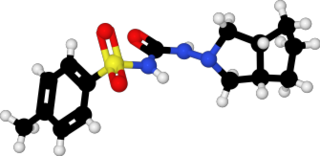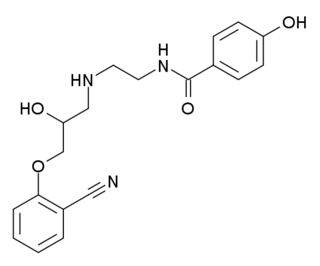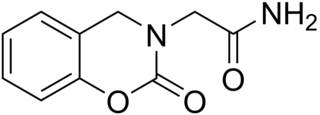Related Research Articles

Ethylmorphine is an opioid analgesic and antitussive.
Enzyme multiplied immunoassay technique (EMIT) is a common method for qualitative and quantitative determination of therapeutic and recreational drugs and certain proteins in serum and urine.

Nomifensine is a norepinephrine-dopamine reuptake inhibitor, i.e. a drug that increases the amount of synaptic norepinephrine and dopamine available to receptors by blocking the dopamine and norepinephrine reuptake transporters. This is a mechanism of action shared by some recreational drugs like cocaine and the medication tametraline. Research showed that the (S)-isomer is responsible for activity.

Guanfacine, sold under the brand name Tenex among others, is an oral medication used to treat attention deficit hyperactivity disorder (ADHD) and high blood pressure. It is not considered a first-line treatment for either indication.

Gliclazide, sold under the brand name Diamicron among others, is a sulfonylurea type of anti-diabetic medication, used to treat type 2 diabetes. It is used when dietary changes, exercise, and weight loss are not enough. It is taken by mouth.
Xamoterol is a cardiac stimulant. It works by binding to the β1 adrenergic receptor. It is a 3rd generation adrenergic β receptor partial agonist. It provides cardiac stimulation at rest but it acts as a blocker during exercise.

Fosazepam is a drug which is a benzodiazepine derivative; it is a water soluble derivative of diazepam. It has sedative and anxiolytic effects, and is a derivative of diazepam which has been substituted with a dimethylphosphoryl group to improve solubility in water.

Abanoquil (INN) is an α1-adrenergic receptor antagonist.

Oxipurinol is an inhibitor of xanthine oxidase. It is an active metabolite of allopurinol and it is cleared renally. In cases of renal disease, this metabolite will accumulate to toxic levels. By inhibiting xanthine oxidase, it reduces uric acid production. High serum uric acid levels may result in gout, kidney stones, and other medical conditions.

Tiflorex, formerly known as flutiorex, is a stimulant amphetamine. Its most pronounced effect is in suppression of appetite; it has little effect on pulse rate, sleep, or mood. It was found to be twice as potent an anorectic as fenfluramine.

Norpropoxyphene is a major metabolite of the opioid analgesic drug dextropropoxyphene, and is responsible for many of the side effects associated with use of this drug, especially the unusual toxicity seen during dextropropoxyphene overdose. It has weaker analgesic effects than dextropropoxyphene itself, but is a relatively potent pro-convulsant and blocker of sodium and potassium channels, particularly in heart tissue, which produces prolonged intracardiac conduction time and can lead to heart failure following even relatively minor overdoses. The toxicity of this metabolite makes dextropropoxyphene up to 10 times more likely to cause death following overdose compared to other similar mild opioid analgesics, and has led to dextropropoxyphene being withdrawn from the market in some countries.

Litoxetine (developmental code names SL 81-0385, IXA-001) is an antidepressant which was under clinical development for the treatment of depression in the early 1990s but was never marketed. It acts as a potent serotonin reuptake inhibitor (Ki for SERT = 7 nM) and modest 5-HT3 receptor antagonist (Ki = 315 nM). It has antiemetic activity, and unlike the selective serotonin reuptake inhibitors (SSRIs), appears to have a negligible incidence of nausea and vomiting. The drug is structurally related to indalpine. Development of litoxetine for depression was apparently ceased in the late 1990s. However, as of March 2017, development of litoxetine has been reinitiated and the drug is now in the phase II stage for the treatment of urinary incontinence.

Epanolol is a beta blocker.

Caroxazone is an antidepressant which was formerly used for the treatment of depression but is now no longer marketed. It acts as a reversible monoamine oxidase inhibitor (RIMA) of both MAO-A and MAO-B subtypes, with five-fold preference for the latter.
Malcolm VandenBurg is a British doctor involved in drug research, sexual health, medicolegal advice and stress management.

Dazoxiben is an orally active thromboxane synthase inhibitor. It has shown a significant clinical improvement in patients with Raynaud's syndrome.

Bufuralol is a potent beta-adrenoceptor antagonist with partial agonist activity. It is metabolized by CYP2D6.

David John Webb, is a British physician, scientist and clinical pharmacologist, who currently holds the Christison Chair of Therapeutics and Clinical Pharmacology at the University of Edinburgh.
Joseph Gavin Collier is a British retired clinical pharmacologist and emeritus professor of medicines policy at St George's Hospital and Medical School in London, whose early research included establishing the effect of aspirin on human prostaglandins and looking at the role of nitric oxide and angiotensin converting enzyme in controlling blood vessel tone and blood pressure. Later, in his national policy work, he helped change the way drugs are priced and bought by the NHS, and ensured that members of governmental advisory committees published their conflicts of interest.
Emma Harriet Baker is a British professor of clinical pharmacology and consultant physician in internal medicine at St George's Hospital, London. She has a specialist interest in people who have multiple medical conditions at the same time and take several medications, with a particular focus on lung disease. She is director of the UK's first BSc in clinical pharmacology, clinical vice president of the British Pharmacological Society and training programme director at Health Education England.
References
- ↑ Jones, Michael A.; Morris, Anne E. (2017). Good practice in prescribing and managing medicines and devices (2013). Blackstone's Statutes on Medical Law (Ninth ed.). Oxford University Press. p. 387. ISBN 978-0-19-880265-5.
- ↑ Kendall, Martin; Enright, Duncan (2012). "An agenda for UK clinical pharmacology: Provision of medicines information: the example of the British National Formulary". British Journal of Clinical Pharmacology. 73 (6): 934–938. doi:10.1111/j.1365-2125.2012.04241.x. ISSN 1365-2125. PMC 3391523 . PMID 22360536.